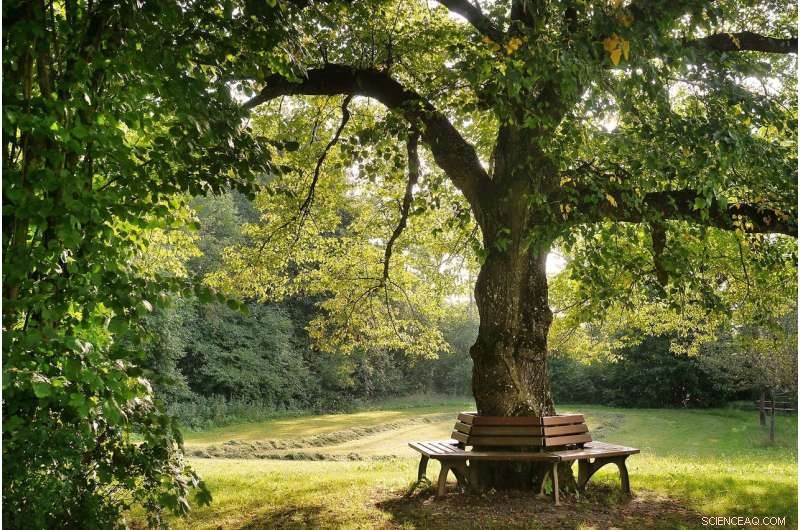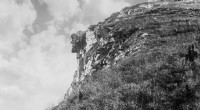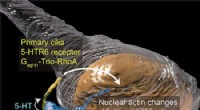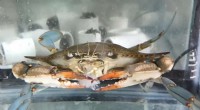LA har brug for 90.000 træer for at kæmpe mod ekstrem varme. Vil beboerne træde til for at plante dem?

Kredit:CC0 Public Domain
I 2019 afslørede borgmester Eric Garcetti en ambitiøs plan om at plante 90.000 træer i Los Angeles inden 2021 som en del af L.A.s Green New Deal.
For at opnå dette udnævnte han byens første skovofficer, Rachel Malarich, til at lede Urban Forestry Division og bemyndigede et netværk af nonprofitorganisationer og "samfundsambassadører" til at hjælpe og opmuntre beboerne til at plante hårdt tiltrængte træer.
Men mere end et år efter Garcettis deadline viser det sig, at det er meget vanskeligere at plante træer i Los Angeles, end det lyder – især når det kommer til at målrette mod de kvarterer, der har størst behov for trædække.
Med lidt over 65.000 træer plantet til dato, oplever embedsmænd, at deres afhængighed af byens indbyggere til at plante og pleje træerne kommer med betydelige begrænsninger:Beboere i fattigere kvarterer, som ikke ejer jord, kan finde det vanskeligt rent faktisk at plante træer, eller de støder på problemer med at passe nye træer i deres kritiske treårige etableringsfase.
I nogle områder - som f.eks. baldakin gold downtown - bliver nye træer ofte ødelagt af køretøjer eller vandaler, før de kan modnes, mens ældre træer bliver fældet af udviklere af nye bygninger eller transportpersonale, der søger at fjerne sigtelinjer i kryds.
Men det er ikke første gang, L.A. har lanceret en storstilet træplantning og løber dog ind i forhindringer. I 2006 lancerede Los Angeles borgmester Antonio Villaraigosa et program til at plante 1 million træer sammen med New York City og Shanghai. Men i april 2013 havde byen plantet lidt mere end 400.000.
Denne gang sagde Malarich, at hun er mere bekymret over lighedsaspektet ved træer, og hvor de bliver plantet frem for antallet. Hun bemærker også, at Garcettis løfte indeholdt et løfte om at øge byens trækrone med mindst 50 % i lavindkomstområder inden 2028.
"Mængden af beskyttelse, vi yder gennem øget kronedække, er vigtigere end antallet af træer," sagde Malarich.
Træer giver Angelenos utallige fordele, herunder opfangning af regnvandsafstrømning og genopfyldning af grundvand, rensning af luften og forbedring af mental sundhed. Forskere har også fundet ud af, at kvarterer med få træer og meget fortov, store bygninger og andre varmeabsorberende overflader kan være 10 grader varmere end omkringliggende områder.
Selv med historiske tørkerestriktioner har eksperter understreget vigtigheden af at fortsætte med at vande træer og holde dem i live. Under den sidste tørke kan så mange som 14.000 træer i L.A.-parker – omkring 4 % af det samlede antal – være døde.
The drought restrictions implemented June 1 by the L.A. Department of Water and Power includes an exception for the hand-watering of trees, however, and should not have an adverse effect on tree health if they are followed correctly, experts said.
As priorities have changed, so have names—Million Trees LA is now called City Plants, a reflection of the emphasis on low canopy areas and maximizing the benefits of trees rather than reaching a specific number. City Plants runs a public-private partnership between the city and six nonprofits to coordinate tree planting and care throughout L.A.
But to get more trees in the ground, it's imperative to have community buy-in—the city itself doesn't do much planting directly. An estimated 90% of L.A.'s urban forest is on private property, and even street trees are often under the care of the residents who live nearby.
City Plants will give seven free trees to any L.A. resident to plant in their yard, thanks to funding from the Department of Water and Power. The trees are delivered to homes, along with stakes, ties and fertilizer pellets. City Plants tracks planting locations and monitors the trees' survival for three years—the most vulnerable period of a young tree's life.
Residents can also request a street tree—one planted in the public right of way—but must sign a Commitment to Water form promising to care for the tree for the first three to five years of its life, which means a deep watering of 10-15 gallons of water once a week by hose or bucket. After the three-year mark, the trees become the responsibility of the Urban Forestry Division.
In some cases, money from City Plants and state grants from the California Department of Forestry and Fire Protection are able to fund the establishment care for the tree—which includes watering, adjusting stakes and ties and anything else needed to ensure survival in the first three years.
The next step, however, is to make sure the communities that need trees have access to them.
The Tree Ambassador program was created last year to develop leaders in historically disadvantaged neighborhoods and assist them in planting and caring for trees in their communities. The inaugural cohort began in September 2021 and ended this April with about 400 trees planted.
The ambassadors serve as community liaisons to help find residents who are interested in planting trees and communicate the importance of caring for neighborhood trees.
"The way we structured that program is really to amplify local leader voices," said City Plants executive director Rachel O'Leary. "And many of those local leaders living in neighborhoods that were historically disinvested—wanting to really, honestly, directly compensate them for their community organizing."
It's a model that not everyone agrees with.
"They're leaning on nonprofits to get there, they're leaning on homeowners to get to that goal (of 90,000 trees)," said Katherine McNenny, co-founder of Industrial District Green, a nonprofit focused on tree planting downtown. "That's cheating."
Giving out trees benefits homeowners who live in areas that might not need more trees, rather than a renter in a low-canopy area, especially with the three-year watering commitment, McNenny said.
"Someone in a low-income community who got a free tree from the city of L.A. a block away … how are they gonna water those trees?" McNenny said.
Though McNenny appreciates the work done by nonprofits, she believes the city itself needs to doing more direct planting and watering by city employees.
On a recent sunny Saturday morning that quickly rose to sweltering temperatures, tree ambassador Cristina Velazquez sat at a green table in Koreatown next to buckets of tree saplings.
Curious locals stopped by to ask—are you really giving away trees for free? How can I get one?
Though most of the trees were reserved for pickup, some were available for same-day adoption—coast live oaks, Canary Island pines, a crape myrtle with showy summer flowers. Velazquez warned some people to carefully consider how much room they had in their yards, because the oaks would get large.
"It is a new member of your family," Cristina Basurto, senior community engagement coordinator for the Koreatown Youth and Community Center, told people who came to take their trees home. "When you talk to them, they thrive even more."
Many people were first-time tree planters and keen on making sure their trees survived. Mulch is good, Basurto advised, but she warned folks against making "mulch volcanoes" around the base of the tree because they can foster too much moisture and cause bark rot. Pomegranates are multi-trunk trees and do particularly well with other pomegranates nearby. And guavas, well you'll have to fight with the squirrels and birds for them.
Some of the people who came to pick up trees were homeowners, though a few were renters who obtained permission from their landlords or lived in a building with a dedicated gardener.
City Plants has been holding various tree adoption events around the city, partnering with organizations like the KYCC, Los Angeles Conservation Corps and Tree People.
"A lot of the open space we have available isn't in the sidewalks; it is in their homes," Basurto said.
But working with disadvantaged communities also means meeting their immediate needs first. When KYCC goes out and offers trees in the communities it's serving, the biggest problem is often litter, which is how Velazquez got involved with the Tree Ambassador program.
When the 24-year-old from Westlake moved home after finishing college in 2020, she noticed that her neighborhood was in bad condition "in terms of public hygiene."
She started a weekly street cleanup group and learned of KYCC, which was planting trees in Westlake and also doing street cleanings. Velazquez said her cleanup group would gather one to two trucks full of litter every week.
"The next step is the tree," Basurto said.
While there's always talk of funding for the trees themselves, what's often neglected is money for establishment care, which is why community buy-in is so important, Malarich said.
One of the partners for the Tree Ambassador program is long-established environmental advocacy group Tree People, which has its own 30-year-old Community Forester Program. Its model also focuses on empowering volunteers to lead tree-planting events in their own communities.
Tree People currently has a grant to plant 1,000 trees exclusively in the Watts neighborhood and distribute thousands more trees for schools and yards, said Ariel Lew Ai Le Whitson, director of education and community. It's applying for another grant to plant 4,000 trees in South L.A.
Not everyone is always excited about getting a tree planted in their neighborhood, however. When walking on the sidewalks of L.A., it's easy to see some of the infrastructure damage caused by trees.
"A resident might have some feelings because a tree was planted there many years ago and maybe messed up their sidewalk," said Eileen Garcia, senior manager of community forestry.
As tree planting efforts continue, City Plants emphasizes its philosophy of "right tree, right place, right reason" to ensure trees aren't causing further damage in the communities they're placed in, executive director O'Leary said.
This issue is exacerbated in historically disadvantaged low canopy areas, where you often see parkways that are too narrow for trees, or trees growing in the public right of way.
Garcia said she hopes to see more funding for more drastic actions such as tearing up large stretches of concrete to create new locations for trees.
The city is currently undergoing a massive tree inventory of street trees and vacant spots, covering 500 square miles, Malarich said. An arborist will visit every tree in the public right of way and record the species, age and size of the tree. Officials hope to complete the study by next summer, and estimate they will count more than 700,000 trees.
Malarich is also overseeing an update of the recommended street tree species list, which has to take into account infrastructure and spacing, climate, and the wide range of soil types that can be found around the city.
But it all comes back to what's important to the community.
"That's part of what's so complex—we have our expert opinion based on science and data related to tree species but we also have a living piece of infrastructure that people have a strong opinion about," Malarich said.
 Varme artikler
Varme artikler
-
 Mimetoliths:De ansigter, vi ser i klippeformationerThe Old Man of the Mountain levede på et udkanten i Franconia Notch, New Hampshire, og var en af de mest kendte mimetolitter i USA, før den faldt i 2003. Libraray of Congress Et almindeligt begreb,
Mimetoliths:De ansigter, vi ser i klippeformationerThe Old Man of the Mountain levede på et udkanten i Franconia Notch, New Hampshire, og var en af de mest kendte mimetolitter i USA, før den faldt i 2003. Libraray of Congress Et almindeligt begreb, -
 Forskere opdager ny form for synapser i neuroner små hårEn model af den serotonerge axo-ciliære synapse. Den serotonerge axon kommer fra hjernestammen (blå) og kontakter de primære cilia (gul). Cilia-specifikke serotoninreceptorer udgør en særskilt signalv
Forskere opdager ny form for synapser i neuroner små hårEn model af den serotonerge axo-ciliære synapse. Den serotonerge axon kommer fra hjernestammen (blå) og kontakter de primære cilia (gul). Cilia-specifikke serotoninreceptorer udgør en særskilt signalv -
 Skjul eller bliv spist, urinkemikalier fortæller mudderkrabberEn blå krabbe i en tank i et forskningslaboratorium ved Georgia Tech. I tanken bagved, små mudderkrabber gemmer sig i plastikrør. Kredit:Georgia Tech / Alex Draper Psssst, mudderkrabber, tid til a
Skjul eller bliv spist, urinkemikalier fortæller mudderkrabberEn blå krabbe i en tank i et forskningslaboratorium ved Georgia Tech. I tanken bagved, små mudderkrabber gemmer sig i plastikrør. Kredit:Georgia Tech / Alex Draper Psssst, mudderkrabber, tid til a -
 Forhistoriske kønssygdomme kan være årsagen til, at mennesker blev monogameDa mennesker flyttede fra en jæger-samler forbi til byer, forekomsten af kønssygdomme steg; dette kan være bag vores praksis med monogami, ifølge en ny undersøgelse. DEA Picture Library/DeAgostini/G
Forhistoriske kønssygdomme kan være årsagen til, at mennesker blev monogameDa mennesker flyttede fra en jæger-samler forbi til byer, forekomsten af kønssygdomme steg; dette kan være bag vores praksis med monogami, ifølge en ny undersøgelse. DEA Picture Library/DeAgostini/G
- Simpel dyremodel afslører, hvordan miljø og tilstand er integreret for at kontrollere adfærd
- Orbital ATK Cygnus skal levere forskning til rumstationen
- Nye kemiske værktøjer til at modificere og studere biomolekyler
- Skælvskader afslører ældre struktur inde i Mexico -pyramiden
- Revolutionerende nyt filter kan forbedre drikkevandskvaliteten
- Hvad er de mest almindelige landformer?


